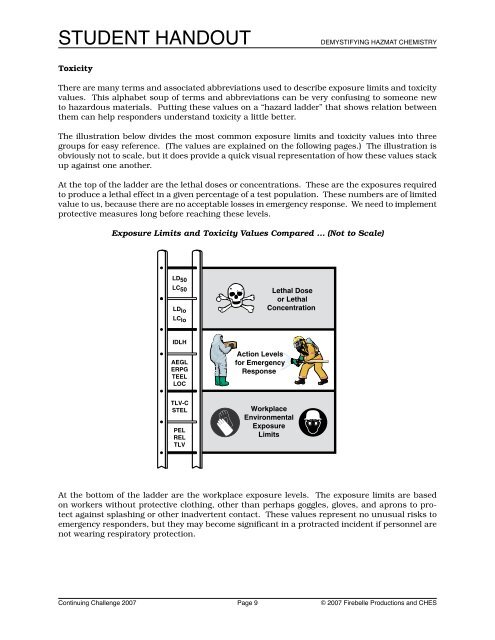Demystifying Hazmat Chemistry
Demystifying Hazmat Chemistry - Firebelle Productions
Demystifying Hazmat Chemistry - Firebelle Productions
Create successful ePaper yourself
Turn your PDF publications into a flip-book with our unique Google optimized e-Paper software.
STUDENT HANDOUT<br />
DEMYSTIFYING HAZMAT CHEMISTRY<br />
Toxicity<br />
There are many terms and associated abbreviations used to describe exposure limits and toxicity<br />
values. This alphabet soup of terms and abbreviations can be very confusing to someone new<br />
to hazardous materials. Putting these values on a “hazard ladder” that shows relation between<br />
them can help responders understand toxicity a little better.<br />
The illustration below divides the most common exposure limits and toxicity values into three<br />
groups for easy reference. (The values are explained on the following pages.) The illustration is<br />
obviously not to scale, but it does provide a quick visual representation of how these values stack<br />
up against one another.<br />
At the top of the ladder are the lethal doses or concentrations. These are the exposures required<br />
to produce a lethal effect in a given percentage of a test population. These numbers are of limited<br />
value to us, because there are no acceptable losses in emergency response. We need to implement<br />
protective measures long before reaching these levels.<br />
Exposure Limits and Toxicity Values Compared ... (Not to Scale)<br />
<br />
<br />
<br />
<br />
<br />
<br />
<br />
<br />
<br />
<br />
<br />
<br />
<br />
<br />
<br />
<br />
<br />
<br />
<br />
<br />
<br />
<br />
<br />
<br />
At the bottom of the ladder are the workplace exposure levels. The exposure limits are based<br />
on workers without protective clothing, other than perhaps goggles, gloves, and aprons to protect<br />
against splashing or other inadvertent contact. These values represent no unusual risks to<br />
emergency responders, but they may become significant in a protracted incident if personnel are<br />
not wearing respiratory protection.<br />
Continuing Challenge 2007 Page © 2007 Firebelle Productions and CHES









